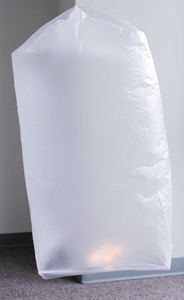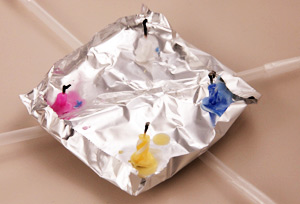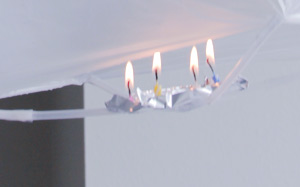Learn about air density as you make a simple hot air balloon in this easy science project. In its simplest construction, a hot air balloon is comprised of an envelope (the balloon part), a basket, and a fuel source. We’ll show you how to construct an envelope from a super-lightweight trash can liner and fuel your balloon with birthday candles.

What You Need:

- Aluminum foil (for the basket)
- Birthday candles (for the fuel)
- Scissors
- Ultra-thin garbage bag (like those lining office trash cans and those that dry cleaners use*)
- Plastic straws (for the frame)
- Clear tape
- Lighter
- Adult supervision and common sense
- Plenty of indoor space
- String (if flying your balloon in a space where it can travel beyond your reach)
*If using a dry cleaner’s bag, you’ll need to seal the hole at the top that the hanger goes through.
FIRE SAFETY: Although this project uses only birthday candles, which even very young children put their faces near when blowing them out on birthday cakes, always exercise extreme caution and utmost common sense when experimenting near an open flame. Make sure there are no flammable liquids nearby, and keep a fire extinguisher or smothering method within reach at all times. Never experiment with fire without adult supervision.
What You Do:
1. Cut a 4 x 4″ square of aluminum foil. This will be your “basket.”
2. Use the lighter to melt wax from the bottom end of the candle so it forms a pool about 1″ in from the corner of the aluminum foil. 
3. Before the wax hardens, press the end of the candle into the melted wax and hold it in place until the candle stands upright on its own. It may take a few tries.
4. Repeat with the remaining candles, placing them 1″ in from the other three corners. Be gentle with the baskets, as too mush jostling will dislodge the candles. If this does happen, simply melt more wax and secure the candle in place again.
5. Fold the edge of the aluminum foil in 1/4 to 1/2 inch, forming a ‘wall’ to contain the wax as it burns, so it won’t drip outside the basket.
6. Measure the width of your bag’s opening and determine how long your straw frame should be. We simply estimated and used trial and error until our frame fit snugly inside the bag’s opening.
7. If using flexible straws, cut off the bendable part so only the straight section remains.
8. You’ll need to fasten the straws into two pieces of identical length for the frame. Each of ours had three straws connected together.
9. To connect the straws, cut a small slit (about 1/4 inch) at the bottom of one straw then insert another straw into the cut end of the first. The slit will make the connection stronger, but secure it with tape for added rigidity, using as little tape as possible.
10. Repeat for the second half of your frame.
11. Find the middle of your straws and tape them together in an “X,” again using as little tape as possible.
12. Place the “X” frame snugly inside the bag’s opening. Using as little tape as necessary, secure it in place.
13. Staggering the straw frame and the candles (so the candles aren’t directly above the straws), tape the basket onto the frame with the candle wicks pointing up into the envelope. 
14. If you’re flying your balloon in an area where it can travel beyond your reach, tie string to the basket, so you can harness it during its flight.
15. Take your hot air balloon to an open, mostly empty room to fly it. (You may try it outside, but even days that don’t seem windy usually have too much breeze for a balloon like this to fly.) We flew ours in our office lobby.
16. Have an adult help you launch the balloon. Have one person hold the closed end of the bag up and away from the basket while the other lights the candles. A lighter with a long stem, like an Aim ‘n Flame, works best. Continue holding the bag until it fills with air and stands on its own.
17. After a minute or so, it should lift off the ground.
What Happened:
One of the important properties of gas is that it expands when it gets hot and contracts when it cools. This means that when a gas is heated, the individual molecules that form it move faster and spread further apart from each other. As a result, the gas also gets lighter as it gets hotter, since the molecules are less densely concentrated.
The expanding property of gas is what enables hot air balloons to inflate and fly. Hot air going into the balloon has a less dense concentration of molecules, making the inflated balloon lighter than the cooler, denser air surrounding it. That denser outer air buoys up the balloon and allows it to float. Conversely, the affect of cooling air will bring the balloon back down—the air molecules inside the balloon move closer together when cooled, making the air in the balloon no longer lighter than the surrounding air. That’s why a cold, damp cloud or fog can be dangerous for a hot air balloon pilot.
Although air might seem weightless, it’s actually formed by gases and has mass like any other matter. Usually air is made up of 78% nitrogen, 21% oxygen, and 1% carbon dioxide and noble gases. The density of air is about 0.075 pounds (or approximately 34 grams—a little more than an ounce) per cubic foot at 70 °F and one atmosphere of pressure. That’s why using lightweight materials was so vital in building this hot air balloon. The weight of the balloon and the air inside it has to be less than the weight of the displaced ambient air in order for it to fly.
Tips & tricks:
- If your balloon fills but won’t lift off, it may be too heavy. Try cutting the birthday candles in half and carefully stripping the wax at one end to reveal the wick: Partially cut through the candle (not completely through) then slide the scissors off, using the blades to scrape away the wax, exposing the wick.
- Or, instead of traditional birthday candles, use the skinniest ones you can find.
- Painters plastic is the right thickness for your balloon, but you’ll have to figure out a way to fasten it into an envelope.





